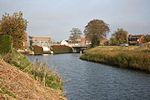Stowgate
Hamlets in LincolnshireLincolnshire geography stubsSouth Kesteven DistrictThe DeepingsUse British English from December 2013
Stowgate is a small settlement in the South Kesteven district of Lincolnshire, England. It is situated approximately 2 miles (3 km) north-east from Deeping St James, and is linked to the Deepings group of villages. Stowgate contains very few houses, most of which are farmhouses. The settlement grew up around Stowgate Farm – the farmhouse of which still exists – which was divided into a number of smaller farms intended to provide housing and agricultural land for those who contributed to war effort. These farms still exist. Stowgate contains a Bernard Matthews turkey farm.
Excerpt from the Wikipedia article Stowgate (License: CC BY-SA 3.0, Authors).Stowgate
Cranmore Drove, South Kesteven Deeping St. James
Geographical coordinates (GPS) Address Nearby Places Show on map
Geographical coordinates (GPS)
| Latitude | Longitude |
|---|---|
| N 52.6808 ° | E -0.2382 ° |
Address
Cranmore Drove
Cranmore Drove
PE6 8RW South Kesteven, Deeping St. James
England, United Kingdom
Open on Google Maps











